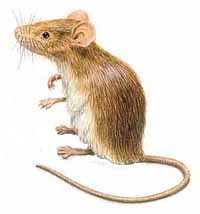House Mouse
Mouse Control: House Mice And How to Remove Them
 Size: The house mouse is small, its body rarely exceeding two inches long and one ounce in weight.
Size: The house mouse is small, its body rarely exceeding two inches long and one ounce in weight.
Colour: Usually grey in colour, but some may appear darker.
Mice are more numerous than rats and are more widespread throughout urban and suburban communities. A mouse can be distinguished from a young rat since the rat’s head and feet will be overly large in relation to its body.
Behaviour – Few people really like rats or mice, and no one wants them in their house. Rodents live everywhere outside and could enter at any time, but fortunately, this does not occur often. Usually, most home invasions occur in the fall, not because of cooler weather, but because the seeds and plants on which rodents feed outside are gone. Rats and mice must then seek new food sources. Unfortunately, one of these sources may be your home. Mice are excellent climbers and are capable of gaining entry through holes around soffit vents and around cables entering the building, through holes in gable vent screens, and through turbine and box vents on roofs. Most garage doors on homes allow enough space for mice to fit underneath, as well.
Habitat – Mice are found in almost every part of the country from urban to rural areas, and are especially prevalent in urban and suburban communities. Mice are found in buildings more often than rats because they are smaller and are able to find more available entryways into a building. Mice can fit through a crack or hole 1/4 of an inch or larger – or about the width of a pencil. Mice will make their nests in many areas in and around the home, especially in stacked firewood, stones and bricks, and piles of leaves or other debris.
Tips for getting rid of mice – The best way to avoid invasions of mice is to (1) provide as little harbourage as possible that might attract rodents, and (2) seal as many holes and cracks in the outside of the home through which mice might enter. Follow these recommendations to help prevent rodents from seeking the shelter provided by your home:
– Keep firewood stored as far from the home as possible and store it off the ground. During the winter, store only enough wood next to the house to burn every couple of days.
– If possible, remove any piles of debris, stones, bricks, etc. If these are near the foundation of the home they serve as harbourages to attract rodents. Once there, it is any easy step for rodents to enter the building itself.
– Do not allow piles of leaves to accumulate next to the home’s foundation. This also serves as attractive harbourage for rodents – mice in particular.
– Seal any hole or crack larger than 1/4 of an inch. A good rule of thumb is that if a pencil can fit into it, a mouse could too. Large holes or cracks should be stuffed with steel wool or wire mesh before sealing with caulk or foam, otherwise rodents could chew through to enter.
– Install good, thick weather-strip on the bottom of all doors to prevent rodents from entering. The garage door may prove difficult to seal completely, so the door from the garage to the house must be sealed tightly.
Call the professionals at Kawartha Pest Control or use the contact form on this page for a free no obligation quote.
